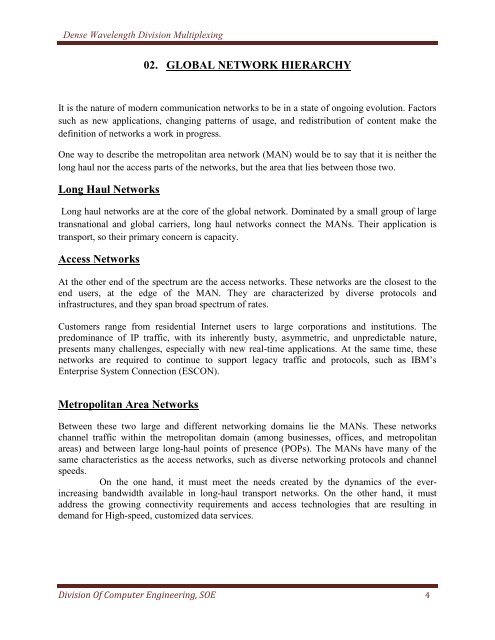Dense Wavelength Division Multiplexing - DSpace at CUSAT ...
Dense Wavelength Division Multiplexing - DSpace at CUSAT ...
Dense Wavelength Division Multiplexing - DSpace at CUSAT ...
You also want an ePaper? Increase the reach of your titles
YUMPU automatically turns print PDFs into web optimized ePapers that Google loves.
<strong>Dense</strong> <strong>Wavelength</strong> <strong>Division</strong> <strong>Multiplexing</strong><br />
02. GLOBAL NETWORK HIERARCHY<br />
It is the n<strong>at</strong>ure of modern communic<strong>at</strong>ion networks to be in a st<strong>at</strong>e of ongoing evolution. Factors<br />
such as new applic<strong>at</strong>ions, changing p<strong>at</strong>terns of usage, and redistribution of content make the<br />
definition of networks a work in progress.<br />
One way to describe the metropolitan area network (MAN) would be to say th<strong>at</strong> it is neither the<br />
long haul nor the access parts of the networks, but the area th<strong>at</strong> lies between those two.<br />
Long Haul Networks<br />
Long haul networks are <strong>at</strong> the core of the global network. Domin<strong>at</strong>ed by a small group of large<br />
transn<strong>at</strong>ional and global carriers, long haul networks connect the MANs. Their applic<strong>at</strong>ion is<br />
transport, so their primary concern is capacity.<br />
Access Networks<br />
At the other end of the spectrum are the access networks. These networks are the closest to the<br />
end users, <strong>at</strong> the edge of the MAN. They are characterized by diverse protocols and<br />
infrastructures, and they span broad spectrum of r<strong>at</strong>es.<br />
Customers range from residential Internet users to large corpor<strong>at</strong>ions and institutions. The<br />
predominance of IP traffic, with its inherently busty, asymmetric, and unpredictable n<strong>at</strong>ure,<br />
presents many challenges, especially with new real-time applic<strong>at</strong>ions. At the same time, these<br />
networks are required to continue to support legacy traffic and protocols, such as IBM’s<br />
Enterprise System Connection (ESCON).<br />
Metropolitan Area Networks<br />
Between these two large and different networking domains lie the MANs. These networks<br />
channel traffic within the metropolitan domain (among businesses, offices, and metropolitan<br />
areas) and between large long-haul points of presence (POPs). The MANs have many of the<br />
same characteristics as the access networks, such as diverse networking protocols and channel<br />
speeds.<br />
On the one hand, it must meet the needs cre<strong>at</strong>ed by the dynamics of the everincreasing<br />
bandwidth available in long-haul transport networks. On the other hand, it must<br />
address the growing connectivity requirements and access technologies th<strong>at</strong> are resulting in<br />
demand for High-speed, customized d<strong>at</strong>a services.<br />
<strong>Division</strong> Of Computer Engineering, SOE 4

















